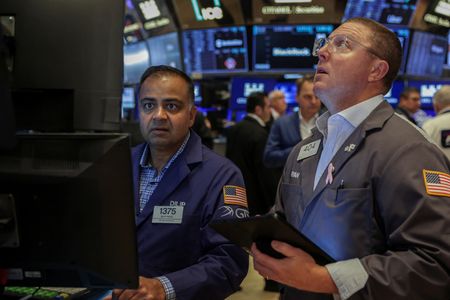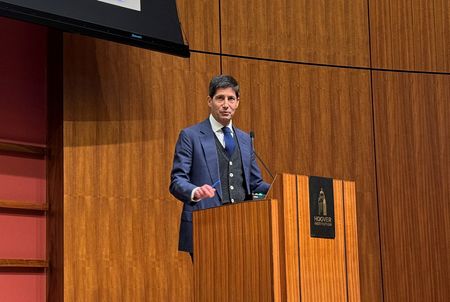By David French
(Reuters) -Wall Street benchmarks closed modestly higher on Wednesday, with the Nasdaq Composite achieving its latest record finish, despite a chaotic half hour when news reports suggested U.S.
President Donald Trump was set to fire Federal Reserve Chair Jerome Powell.
Shortly before midday, the benchmark S&P 500 and Nasdaq fell more than 1%, while the dollar plunged and Treasury yields rose, after Bloomberg News reported the possibility of replacing Powell, citing an unidentified White House official.
Separately, Reuters News reported, citing a source, that Trump was open to the idea of firing Powell.
Trump was quick to deny the reports, even as he unleashed a new barrage of criticism against Powell for not cutting interest rates.
“The Fed’s independence is hugely important to our overall economy, so you saw the market react when that initial headline came out,” said Dylan Bell, chief investment officer at CalBay Investments.
Trump’s denial revived equity markets, with the Nasdaq Composite closing at 20,730.49, a gain of 52.69 points, or 0.26%.
It was the fifth session in six that the technology-heavy index has posted a record high.
The Dow Jones Industrial Average rose 231.49 points, or 0.53%, to 44,254.78, and the S&P 500 gained 19.94 points, or 0.32%, at 6,263.70.
Since Trump’s April tariff announcement, which initially sent U.S.
equities into a spin, U.S. stock markets have been on a tear. The S&P 500 most recently posted a record finish last week.
Amid this buoyancy, though, has been investor angst about the prospect of Powell being removed from his job before his term ends next May, as Trump has repeatedly criticized him for not cutting U.S.
rates quickly enough.
The CBOE Volatility Index, Wall Street’s “fear gauge,” hit a more than three-week high in the wake of the initial Powell reports, but eased from those levels.
CalBay’s Bell said while volatility risk from news headlines would persist, the overall positive state of the U.S.
economy was a more important factor in driving investor moves.
Despite Trump’s demands for easier credit, Fed officials have resisted cutting rates until there is clarity on whether his tariffs on U.S.
trading partners reignite inflation.
This concern was iterated by Atlanta Fed President Raphael Bostic on Wednesday, saying in a Fox Business interview that pressures may be building in the wake of rising import taxes.
Inflation has been in focus this week.
Producer prices data released on Wednesday showed growth flatlined in June, as tariff-driven goods costs were balanced out by weaker service prices.
Just a day earlier, unexpectedly strong consumer inflation had already dented hopes for deeper Fed rate cuts, with Trump’s tariffs partly fueling the uptick in prices.
On Wednesday, the second day of this earnings season, another round of stronger profits from Wall Street’s big banks failed to ignite their own stock prices.
Goldman Sachs climbed 0.9% after notching a 22% earnings surge, while Bank of America and Morgan Stanley declined 0.3% and 1.3%, respectively, despite posting higher profits.
Johnson & Johnson soared 6.2%, and was the second-best performer on the S&P 500, after halving its expectations for costs this year related to new tariffs and raising its full-year sales and profit forecast.
Semiconductor stocks were sluggish after news that Nvidia would be allowed to sell its H2O chips in China had fueled gains in the previous session.
The semiconductor index slipped 0.4%, from the 12-month high recorded on Tuesday.
(Reporting by Sruthi Shankar, Pranav Kashyap and Nikhil Sharma in Bengaluru and David French and Suzanne McGee in New York; additional reporting by Medha Singh; Editing by Saumyadeb Chakrabarty, Maju Samuel and Richard Chang)











